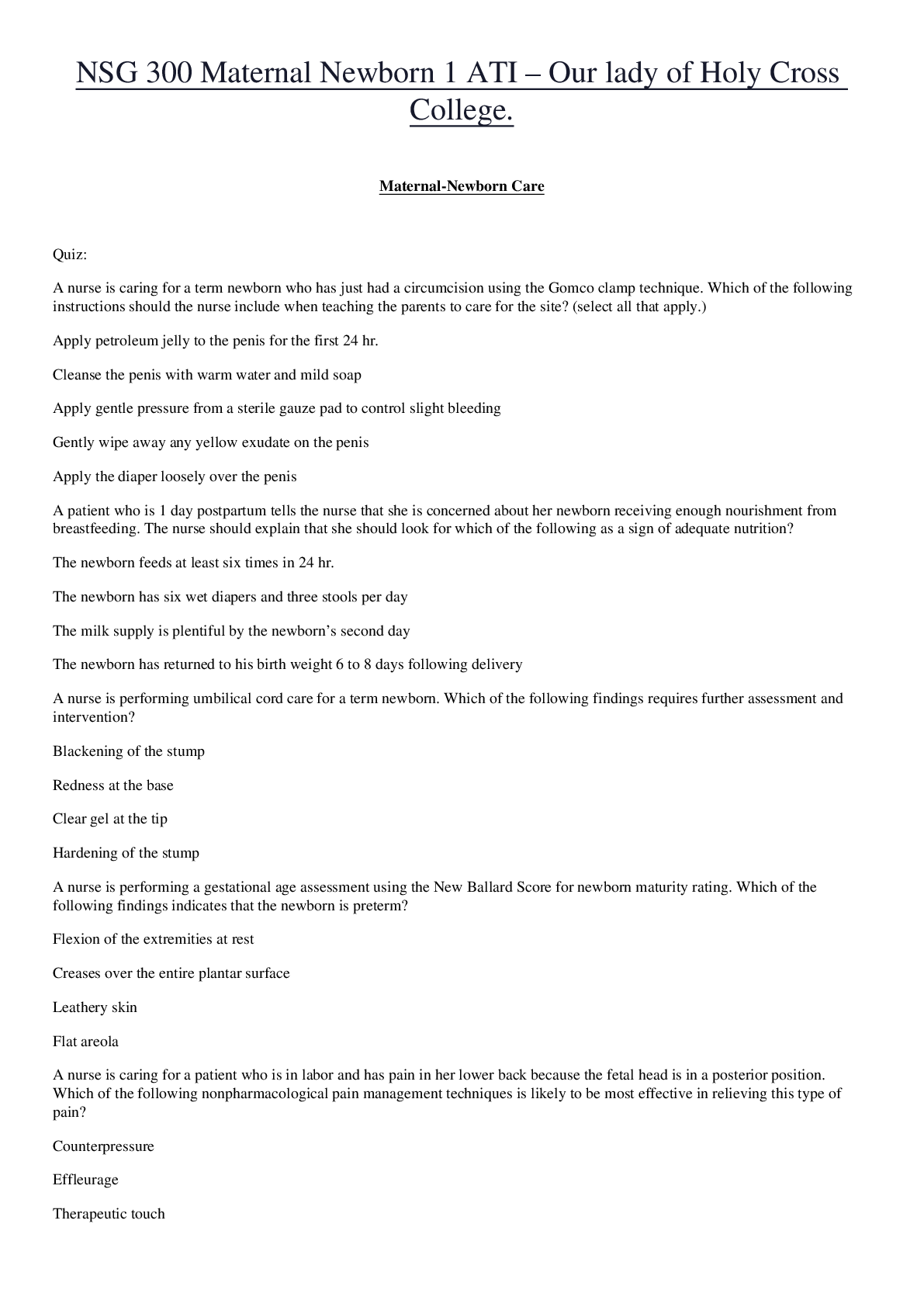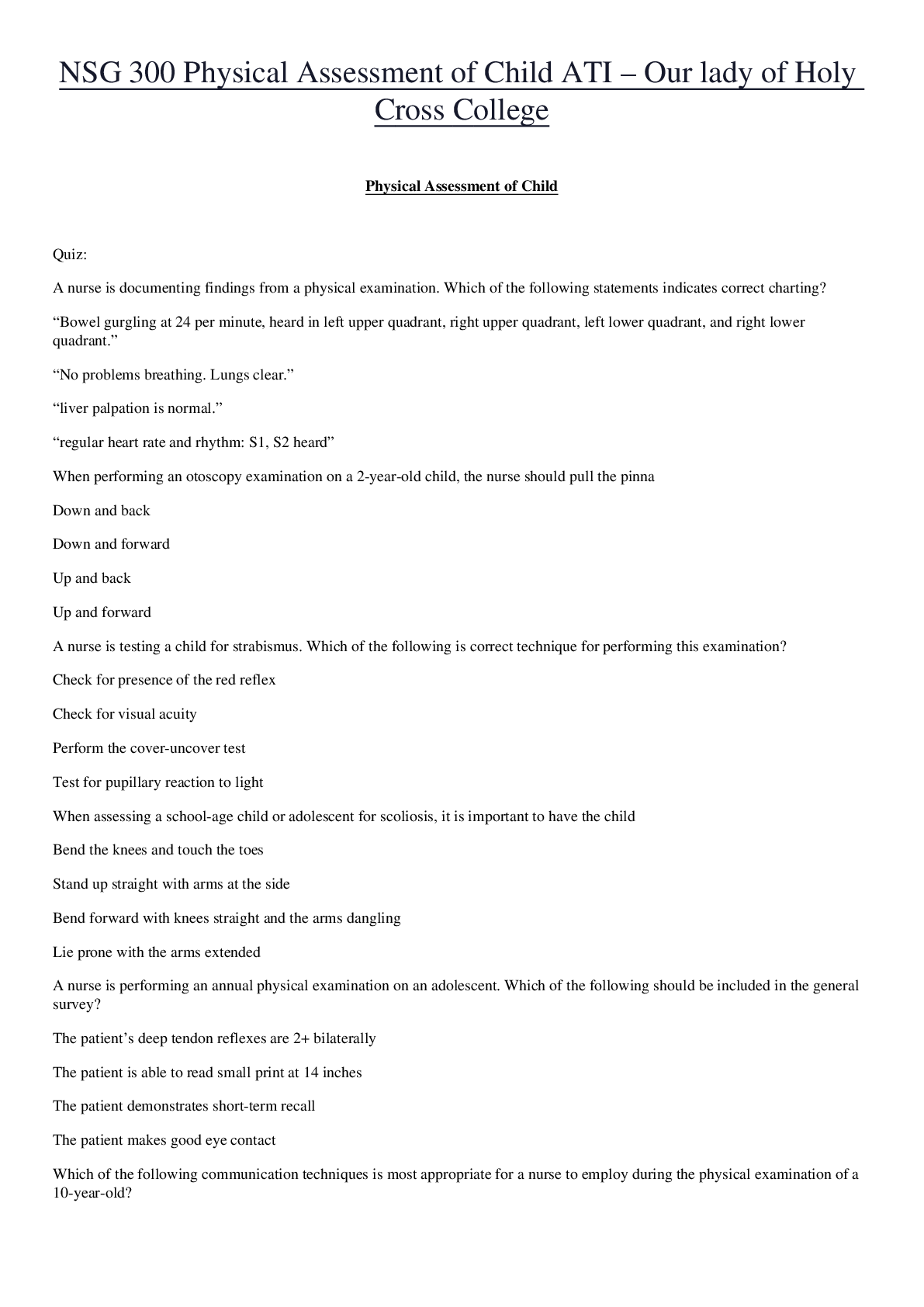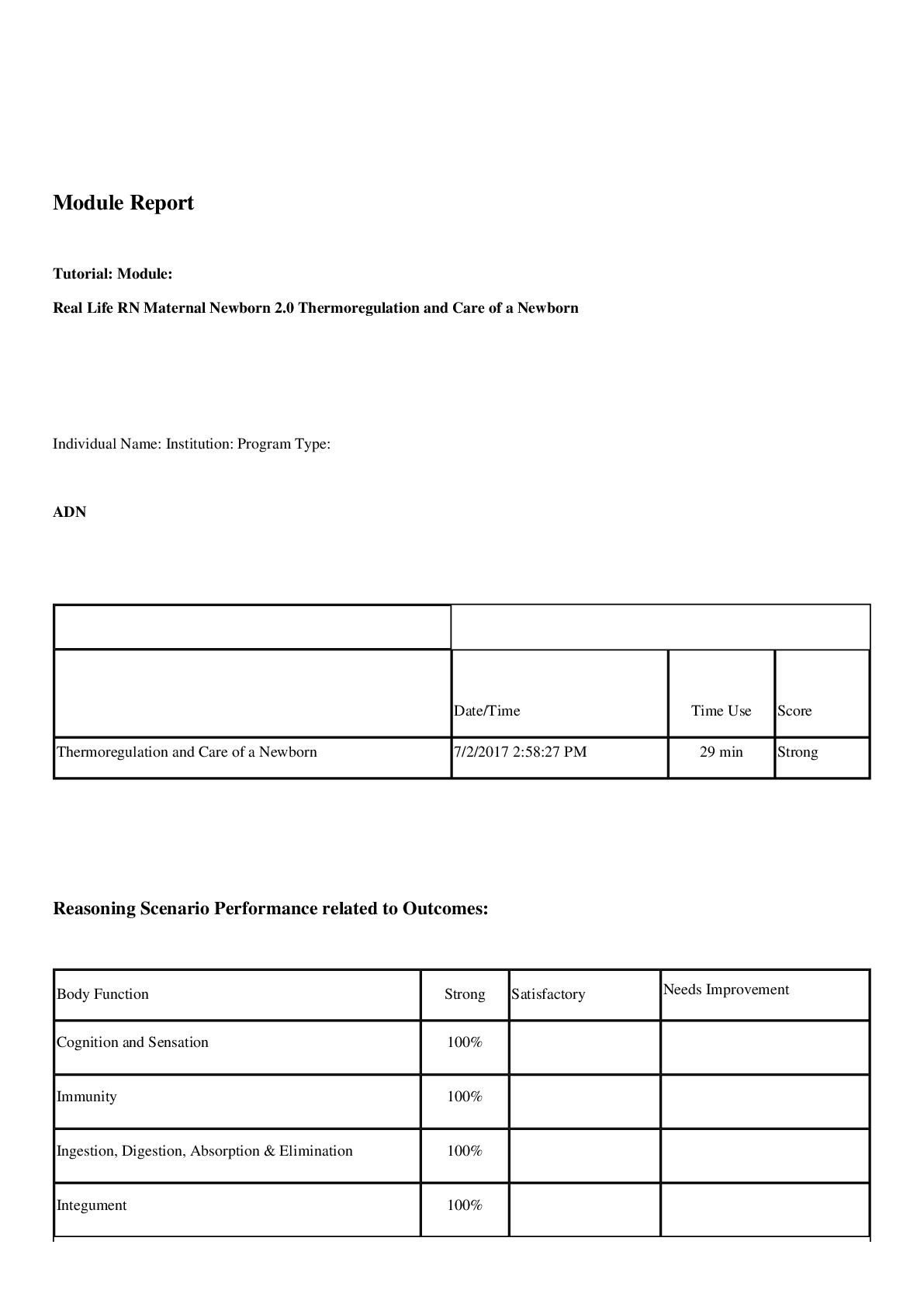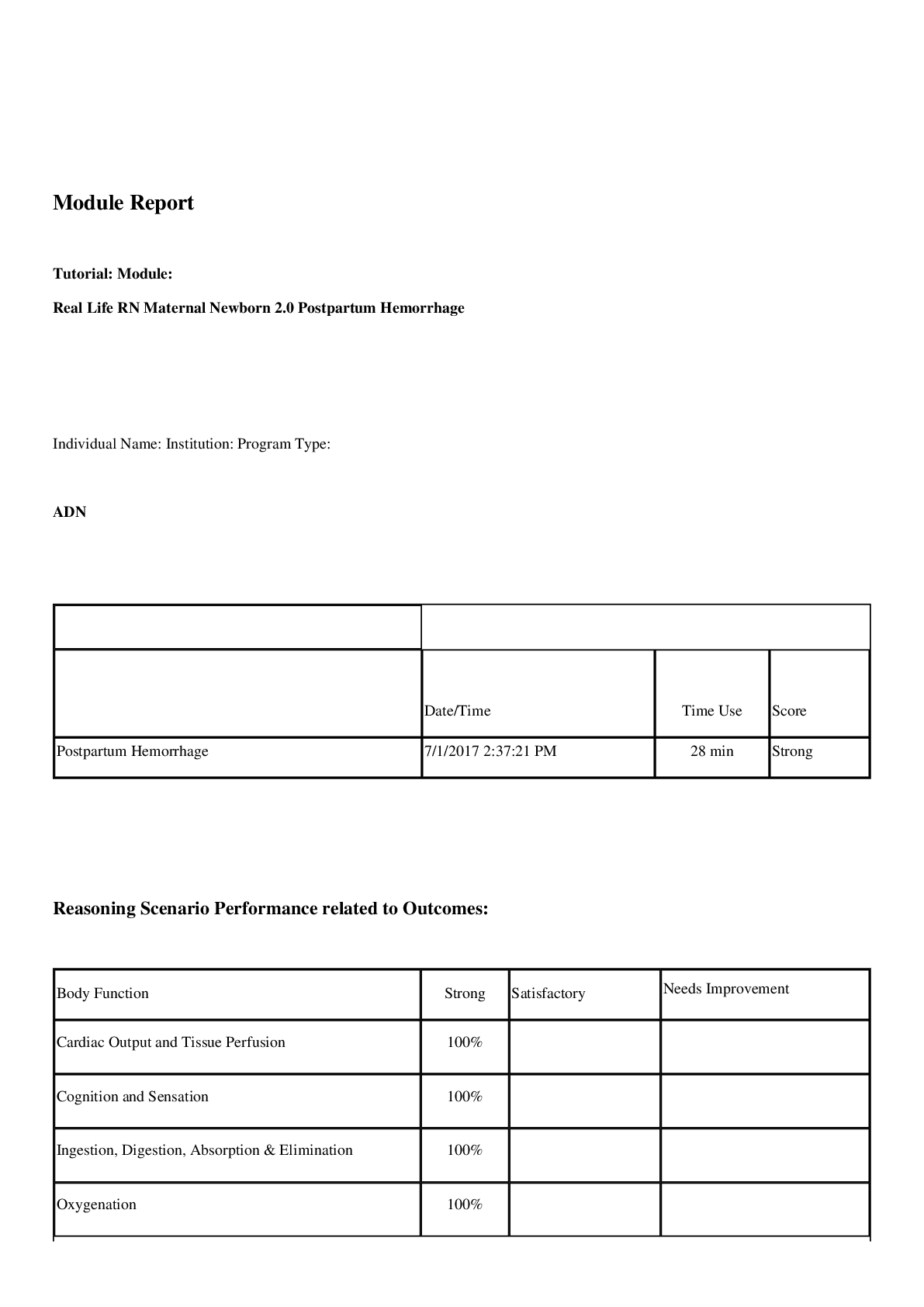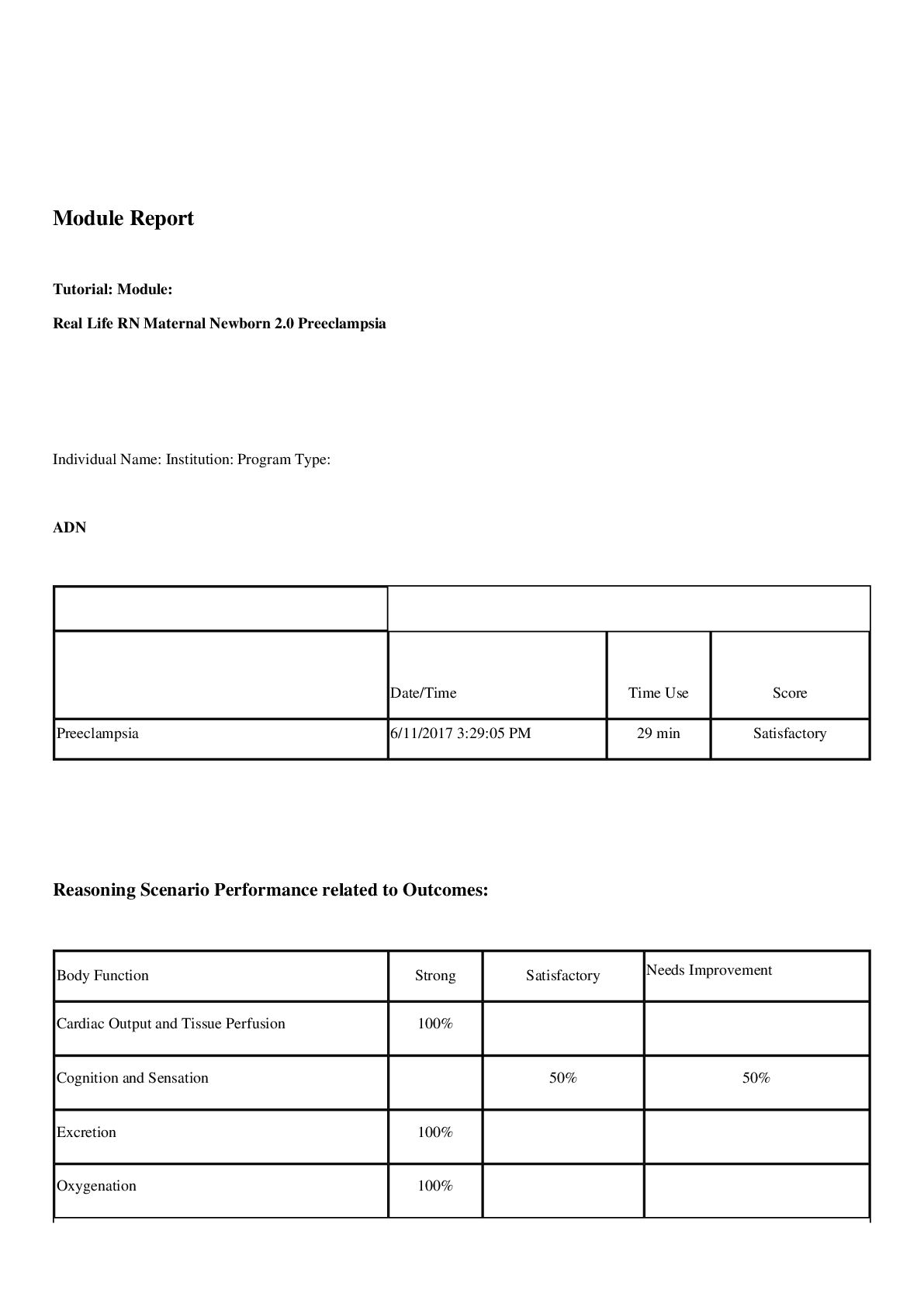*NURSING > EXAM > NSG 300 Maternal Newborn 2 ATI – Our lady of Holy Cross College / NSG 300 Maternal Newborn 2 ATI (All)
NSG 300 Maternal Newborn 2 ATI – Our lady of Holy Cross College / NSG 300 Maternal Newborn 2 ATI
Document Content and Description Below
NSG 300 Maternal Newborn 2 ATI – Our lady of Holy Cross College. Maternal Newborn 2 1. A nurse is evaluating the degree of bonding between a mother and her infant who has been hospitalized for... a high bilirubin. To collect this data the nurse should Top of Form a. find out if the pregnancy of this infant was planned. b. provide a cot so that the mother can stay with the infant. c. ask the mother how she feels about her infant. d. observe the mother feeding the infanBottom of Formt 2. A nurse caring for a client 14 hr after delivery assesses the following: breasts soft; fundus firm, uterus slightly deviated to the right; lochia moderate rubra; temperature 37.8° C (100° F), pulse 88/min, and respirations 18/min. Which of the following nursing actions should be initiated? a. Notify the provider of the elevated temperature. b. Ask the client to empty her bladder. c. Suggest that the client nurse her infant. d. Massage the client's fundus. 3. A nurse is caring for a newborn in the newborn nursery who weighs 4 lb and 4 oz. Which of the following is a correct conversion pounds to kilograms for this newborn's weight? a. 1.93 kg b. 2 kg c. 9.35 kg d. 9.68 kg 4. In planning postpartum nursing care for a client with cardiac disease, the nurse would question which of the following provider orders? a. Strict intake and output b. High fiber diet c. Force fluids d. Monitor vital signs every 2 hr 5. Which of the following statements made by a client who is nursing should indicate to the nurse that the client has a good understanding of breastfeeding? a. "I must drink milk every day in order to assure good quality breast milk." b. "Fluid intake is very important to adequate breast milk production." c. "I need to add 500 calories to my pregnancy diet to meet both of our nutritional needs." d. "I should avoid nursing my baby more often than every 4 hours." 6. While assessing a 2-day-old newborn, the nurse finds a soft spot on the left side of the newborn's head. Careful inspection reveals a bluish discoloration with edema that does not cross the suture line. What information should the nurse give to the mother when she inquires about the finding? a. "This will resolve within 2 to 6 weeks without treatment." b. "This will resolve on its own within 2 or 3 days." c. "I will ask the doctor to examine your baby’s head carefully this morning." d. "Don’t worry about it; it’s normal." 7. A nurse is caring for a client who has had a cesarean birth and is reporting abdominal distention. Which of the action should the nurse implement? a. Suggest that the client ambulate in the hallway. b. Request a narcotic analgesic be ordered. c. Position the client lying on her right side. d. Encourage the client to drink carbonated drinks. 8. A nurse is caring for a 30 week gestation premature infant. Which of the following in an expected assessment finding? a. Abundant lanugo b. Good flexion c. Heel creases d. Dry, flaky skin 9. A nurse is assessing a newborn immediately after birth and makes these observations: heart rate 136/min, respirations 36/min, vigorous cry, active movement, and acrocyanosis. The nurse should assign an Apgar score of a. 7. b. 8. c. 9. d. 10. 10. When planning the care of a preterm newborn being discharged home with the use of an apnea monitor, the nurse should want the caregivers to give a return demonstration on which aspect of newborn care? a. Position for sleeping b. Electrode placement c. Clustering of care d. Schedule for feeding 11. A nurse is assessing a neonate born at 39 weeks of gestation. Which characteristic is the nurse most likely to find in this neonate? a. Creases covering the entire bottom of both feet b. Dry, wrinkled skin c. Vernix well distributed over entire body d. Lanugo abundant over shoulders 12. A nurse on the postpartum unit is caring for a client on the day of delivery and assisted her out of the bed for the first time. The client becomes frightened when she passes a blood clot and notices an increase in her lochia. Which information should the nurse include in an explanation to the client? a. "You may have retained placental fragments in your uterus." b. "The blood pools in the vagina when you are lying in bed." c. "You might have a uterine or urinary tract infection." d. "The amount of blood flow will increase during the first few days." 13. A nurse is caring for a newborn immediately after delivery. Which of the following is the priority nursing action? a. Examine the newborn to rule out any birth defects. b. Dry the newborn and place in a warm environment. c. Administer Vitamin K IM. d. Instill erythromycin solution into the newborn's eyes. 14. A nurse has just given a rubella vaccine to a client who is 2 days postpartum. Which of the following statements by the client should alert the nurse to the client’s need for further instruction? a. "I may experience a mild rash and joint aches in a week or two." b. "I will still need to have a rubella titer with my next pregnancy." c. "I may get a low-grade fever after this shot." d. "I can conceive any time I want after 10 days." 15. Which medication does the nurse need to administer to all newborns within 1 hr after delivery? a. Naloxone (Narcan) b. Erythromycin ophthalmic (Ilotycin) c. Potassium chloride (Apo-K) d. Hepatitis B vaccine (Heptavax-B) 16. A nurse is caring for a client following a normal vaginal birth. The nurse gives the client an IV containing oxytocin (Pitocin). Which assessment does the nurse need to perform to evaluate the effectiveness of this medication? a. Urinary output b. Blood pressure c. Fundal consistency d. Pulse rate 17. A nurse in the obstetrical unit is caring for a newborn. Which of the following assessment findings should be reported to the primary care provider? a. Jaundice of the sclera in a 4-hr-old newborn b. Respiratory rate of 50/min in an 8-hr-old newborn c. Acrocyanosis in a 2-hr-old newborn d. A blood glucose of 60 mg/dL in a 1-hr-old newborn 18. A nurse is about to administer methylergonovine (Methergine) maleate to a postpartum client. Which nursing assessment should be conducted prior to the administration? a. Respiratory rate b. Fundal height c. Apical pulse d. Blood pressure 19. A nurse is caring for a postpartum client 8 hr postdelivery. Which of the following factors places the client at risk for postpartal atony? (Select all that apply.) a. Precipitous delivery b. Distended bladder c. Vaginal delivery d. Periurethral tear e. Macrosomic delivery 20. At 12 hr of age, an infant’s respiratory rate is 44/min. The respirations are shallow with periods of apnea lasting up to 5 seconds. Which of the following actions should the nurse conduct based upon this assessment data? a. Request a consult from respiratory therapy. b. Notify the infant’s provider immediately. c. Continue routine monitoring. d. Obtain an order for supplemental oxygen. 21. A client has a postpartum hemorrhage as a result of a cervical laceration. Which of the following assessment findings should the nurse expect to observe? a. Continuous vaginal bleeding in presence of a boggy uterus. b. Rapidly rising fundal height with continuous vaginal bleeding. c. Continuous vaginal bleeding in the presence of a firm fundus. d. Intermittent vaginal bleeding in the presence of a relaxed uterus. 22. A client who is primigravida delivers a newborn who is 7 lb via vaginal delivery. The client states that she plans to breastfeed. Four hours later, the nurse assesses that the client’s fundus is firm, one fingerbreadth above the umbilicus, and deviated to the left. She has moderate lochia rubra and has voided 150 mL since delivery. The client asks for her infant. The nurse’s first action should be to a. bring the infant to the client so that she can nurse. b. massage the client’s uterus. c. encourage the client to drink more fluids. d. palpate the client’s bladder. 23. While assessing a client who gave birth 1 hour ago with an epidural block, the postpartum recovery room nurse discovers that the client has saturated a perineal pad within 20 min. Which of the following actions should the nurse conduct? a. Encourage the client to void. b. Slow down the IV solution containing oxytocin (Pitocin). c. Place the client in the Trendelenburg position. d. Massage the client’s fundus. 24. A nurse in the newborn nursery is providing care of a 4 hr old newborn. Assessment findings reveal hands and feet that are cool and slightly blue. Which of the following is an appropriate nursing action? a. Place the newborn on oxygen. b. Notify the newborn's provider. c. Swaddle the newborn in blankets. d. Put the newborn in an isolate. 25. When assessing a newborn for congenital hip dysplasia, the nurse should be alert for a. flexion of one leg while extending the other leg. b. negative Ortolani sign. c. symmetrical gluteal folds. d. limited abduction of one hip. 26. A nurse is to administer naloxone (Narcan) to an infant weighing 3.5 kg. The suggested dosage is 0.1 mg per kg, and the medication is supplied in a vial labeled 0.4 mg/mL. How much will the nurse administer to the infant? a. 0.14 mL b. 1.4 mL c. 0.35 mL d. 0.88 mL 27. A nurse is testing a neonate’s reflexes to assess neurologic maturity. Which reflex is the nurse testing by quickly and gently turning the neonate’s head to one side? a. Startle b. Moro c. Tonic neck d. Babinski 28. A nurse is caring for a 3-day-old infant who is receiving phototherapy for an elevated bilirubin. A nursing action that would put the client is at risk would be to a. swaddle the infant to maintain body temperature. b. keep the eyes and genitalia covered at all times. c. feed the infant every 2 hr. d. allow the parent to hold the infant to promote bonding. 29. What should the nurse include in a postpartal plan of care for a client who does not plan to breastfeed? a. Suggest that the client stand under a hot shower with her breasts exposed. b. Have the client place ice packs on her breasts. c. Have the client wear a loose-fitting, comfortable bra. d. Encourage the client to drink at least eight 8-oz glasses of water per day. 30. A nurse is caring for four neonates in the nursery. Which of the following neonates is at greatest risk for hypoglycemia? a. Neonate of a substance abuser b. Neonate with Rh-incompatibility c. Postmature neonate born at 42 weeks d. Neonate who is large for gestational age (LGA) [Show More]
Last updated: 2 years ago
Preview 1 out of 7 pages

Buy this document to get the full access instantly
Instant Download Access after purchase
Buy NowInstant download
We Accept:

Reviews( 0 )
$12.00
Can't find what you want? Try our AI powered Search
Document information
Connected school, study & course
About the document
Uploaded On
May 26, 2020
Number of pages
7
Written in
Additional information
This document has been written for:
Uploaded
May 26, 2020
Downloads
0
Views
96








 – University of the People.png)






